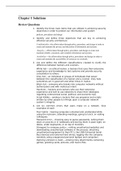Samenvatting
Samenvatting How the Special Needs Brain Learns, Onderwijsleerproblemen
- Vak
- Instelling
- Boek
Dit document bevat een samenvatting van het boek: "How the Special Needs Brains Learns" dat tentamenstof is voor het tentamen van het vak Onderwijsleerproblemen.
[Meer zien]













